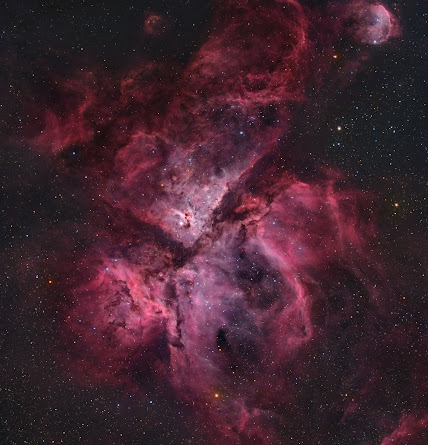All about Nebulae
Nebula
Nebulae are a huge interstellar clouds made up of dust particles, hydrogen, helium and other ionized atoms. These things are vast in size, some stretching upto hundreds of light years in diameter. They were first formed because of the Big Bang as they contain the fundamental elements needed to form stars and galaxies. Nebulae are usually the nursery for new stars. Nebulae are often star-forming regions. In these regions, the formations of gas, dust, and other materials clump together to form denser regions, which attract further matter and eventually become dense enough to form stars.
They either form through clouds of cold interstellar gas and dust or through the aftermath of a supernova explosion. Star-forming nebulae collapse under its own weight, producing stars. Massive stars may form in the center and their ultraviolet radiations ionize the surrounding gas, making it visible at optical wavelengths. Other nebulae that are formed as a result of supernova explosion, that is the death of huge stars. Materials thrown off from the supernova explosion for these kind of nebulae.
Now let's move on to the different types of Nebulae. There are 4 main types: Planetary, Reflection, Absorption and Emission nebulae.
Planetary nebula is created when a star blows off its outer layer after it runs out of fuel to burn. These outer layers of gas expand into space forming a nebula which is often the shape of a ring or a bubble. At the very center of planetary nebula is a glowing leftover of a star.
Reflection nebula is a cloud of gas and dust which does not create its own light but instead it shines by reflecting light from nearby stars. The brightest reflection nebulae are places where new stars are being formed. Here the gases and dust is thick so it reflects the light from the new bright stars. Sometimes the gas is so thick that the new stars cannot actually be seen as they are blanketed by the gas of the nebula. But under infrared light, these stars come to life. So in astronomy pictures, we see dark clouds in space.
What exactly are they? Well, the dark clouds in space are called Absorption nebulae or Dark nebulae. An absorption nebula is a cloud of gas and dust which blocks light from regions of space behind it. As the light from space reaches an absorption nebula, it is absorbed by it and therefore cannot pass through it. Absorption nebulae do not create their own light. It is actually very difficult to find one in space unless it is situated against a much brighter region of space.
So we see these glowing clouds in space. The glowing clouds that you see in the pictures from space are called Emission nebulae. An emission nebula is a hot glowing cloud of dust and gas in space. These nebula absorb the light of nearby stars and therefore reach a very high temperature. This high temperature causes it to glow. Emission nebulae are often found in regions of space where new stars are forming.





Comments
Post a Comment